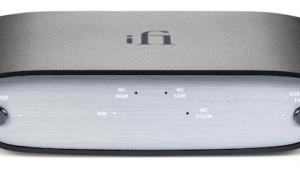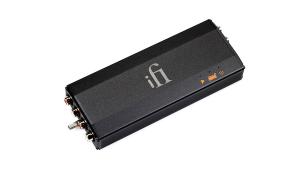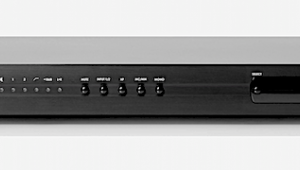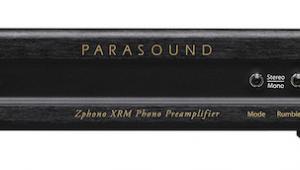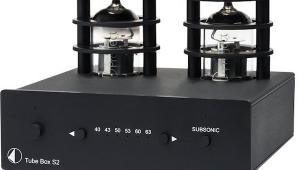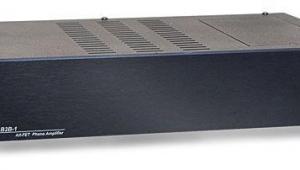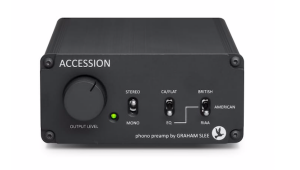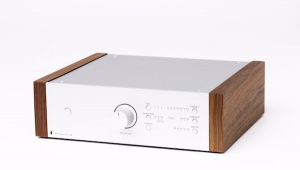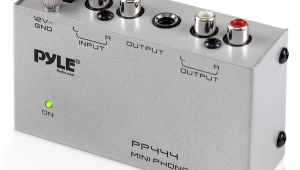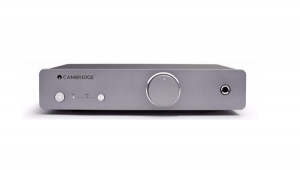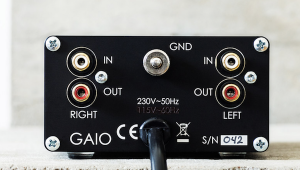Audio Research Reference phono preamplifier

The cost-no-object company kept the Reference's sticker price down not by skimping on the parts or build quality of its original vision, but by leaving out the variable equalization feature it intended to include.
For those of you new to analog playback (yes, even at this late date, there are happily many new converts): In order to increase the amount of music on an LP side and to make tracking easier, bass is rolled off in the disc-cutting process, while high frequencies are boosted in playback, an inverse curve is applied to the signal that restores overall flat response and lifts the music well above the LP's noise floor.
During the LP's early days, many labels devised their own compensation curves. In fact, many early phono preamps included various user-selectable curves. Eventually, the RIAA (Recording Industry Association of America) standardized a curve that the American and many foreign recording industries adopted.
Audio Research concluded that including the costly variable equalization feature was not a wise move, given that the vast majority of LPs played by most potential Reference buyers are encoded with the RIAA curve. Why ask them to pay more than $3000 for a feature they wouldn't be using, and for one that the company claims potentially destroys the sound? (Ironically, as I was preparing this review, I received a call from an importer of a very expensive Japanese phono preamp that includes the variable EQ feature. The designer's research told him that, even among labels adopting the RIAA curve, there are variables that affect the sound.)
Nonetheless, Audio Research—and most other electronics manufacturers offering premium-priced phono sections—have focused their attention on the difficult task of getting the RIAA curve right and leaving it at that. FM Acoustics is one of the few companies to offer variable EQ in its phono sections; owners of large collections of pre-RIAA LPs and 78s should consider a variable-EQ unit.
For the rest of us, though, there's this end-of-millennium gift to chew on: a 14-tube, no-compromise phono section from one of America's premier high-end electronics manufacturers. Review time well spent!
Design
Design is about choice, and Audio Research has chosen to go with a tube-based power supply that includes a 5AR4 rectifier tube. According to AR engineer Rich Larson, a tube power supply is "easier on other tubes." For one thing, there's an inherent time delay, so the heaters warm up together. According to Larson, there's also greater headroom and less ringing. Regulation throughout the circuit is solid-state.
While many designs (including AR's PH3 and PH3 SE models) use solid-state-based "head amps" to boost the ultra-low voltages produced by some moving-coil phono cartridges, the Reference uses a pair of premium Jensen transformers to give the High Gain input an impressive 69dB of gain (63dB is available as a factory-installed option) with ultra-low noise specs—and no transistors in the signal path. The Low Gain input, which bypasses the transformers, gives 48dB of gain (43dB is available as a factory-installed option). Both inputs are compatible with moving-coils, and while AR gives you a guide as to which input to use with an MC cartridge of given output, some models will fall in between, in which case use the input that sounds best.
Eleven dual-triode 6922 (6DJ8) tubes handle the amplification. Passive HF equalization is applied to the first group of tubes, while the LF boost is achieved through an active feedback circuit. According to Larson, this design achieves the "best balance overall, but it requires more tubes." The high tube count improves the sound, according to Larson, because each tube is not working as hard, and the number allows for more cathode followers, which give better isolation and improved high-frequency response.
I asked Larson why 6922s and not the other obvious choice, 12AX7s. In his opinion the 6922 sounds better, has lower noise and microphonics, and is a more consistent performer [and, of course, Audio Research has a long history with the 6DJ8 tube and its derivatives, such as the 6922, since its SP8 and SP10 preamplifiers of 1984—Ed.]. Designers using 12AX7s will, of course, beg to differ.
Setup and use
The AR Reference is shipped with the tubes out, packed in foam inside the chassis. The user has to remove 20 Philips-head sheet-metal screws (AR includes a high-quality screwdriver) to access the inside. There are two vertically mounted circuit boards, one at the front for the power supply and one at the rear, adjacent to the input and output jacks for the EQ and amplification circuitry. Each tube (including all eleven 6922s) bears a label indicating where it should be plugged in, and the tubes are fitted with damping rings (see Sidebar). Installation is easy, though you must be careful not to break off or bend any heatsink fins when installing the lower row of tubes. Then it's time to replace those 20 screws—unless you wish to use the supplied resistors to change the factory-set loading. According to Larson, tube life should be in excess of 4000 hours, so you shouldn't have to remove the top cover too often.
The low-gain inputs are factory-set for the moving-magnet standard of 47k ohms of resistive loading and 180pF of capacitance. The high-gain input is set for 280 ohms, which might create problems for "true believers" in wide open (47k ohms) MC cartridge loading. For those wishing to further load down the High Gain side, there are posts near the inputs to which you solder the supplied resistors. (Various combinations of these yield 30, 60, 100, 200, and 800 ohms. AR can supply other values.) You can also change the Low Gain's 47k ohm setting (don't for MM cartridges), or increase the capacitance.
I have long been as doctrinaire about the need for loading down MC cartridges as some of you probably are about not doing so. Most MC cartridges suffer from rising high-frequency response due to undamped resonances in the audioband. Yet some listeners prefer the "air" and "spaciousness" of an undamped MC.
I've had long, involved discussions on this subject with many cartridge and phono-section designers, and, unfortunately, there is no consensus. When I challenged one advocate of 47k ohm loading to view on an oscilloscope the rising high-end frequency response of an undamped MC cartridge—proof to me of the need for loading—he responded that he could prove to me that even the best 'scopes ring under such test conditions, thus rendering the results essentially meaningless. [All oscilloscopes can be adjusted not to ring on squarewaves, so I am a little puzzled by this argument.—Ed.]
Most of the people with whom I spoke conclude that to load or not to load is more a matter of trial and error and of cartridge/phono-section interaction than anything else. So, all true believers in 47k ohm loading for low-output MCs: Before you dismiss this gem as "unacceptable" because it forces you to load your expensive little treasure down to 280 ohms...read on.





